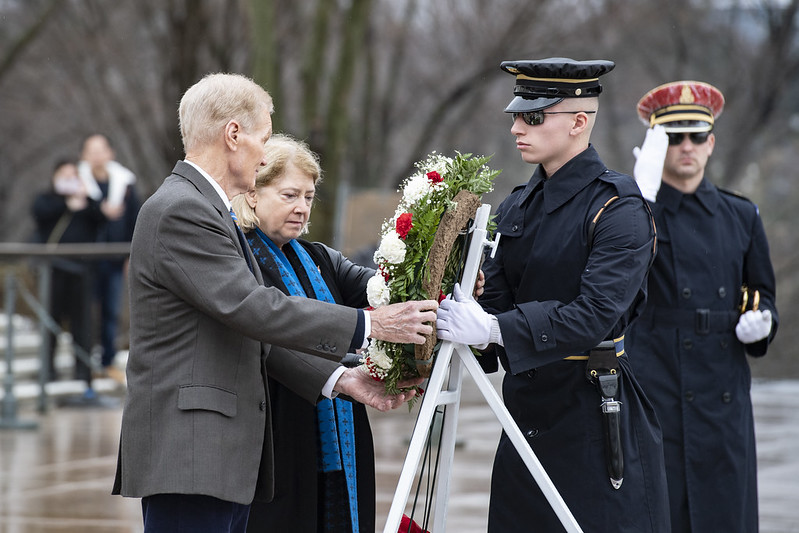
"We are here to remember so that we never repeat the mistakes of the past,” NASA Administrator Bill Nelson told a gathering of more than 100 NASA employees, family members and friends at Arlington National Cemetery on Jan. 25, 2024, NASA’s annual Day of Remembrance. “Because of Apollo 1, Challenger and Columbia, we honor 17 souls deep in our hearts.” Traditionally held on the fourth Thursday in January, the NASA Day of Remembrance commemorates the crews of Apollo 1 and space shuttles Challenger and Columbia—all of whom are honored with monuments at ANC. The timing of the annual remembrance reflects the anniversaries of the three disasters, which happened to occur between the dates of Jan. 27 and Feb. 1.
The NASA group came to the cemetery to lay wreaths at the Tomb of the Unknown Soldier, as well as the Space Shuttle Challenger and Columbia Memorials in nearby Section 46. They also laid a wreath at the Apollo 1 Monument and placed flowers at the graves of astronauts Gus Grissom and Roger Chaffee, all of which are in Section 3.

On Jan. 27, 1967, Apollo 1’s command module experienced a fire during a pre-launch test, which killed its three-man crew—who would have been the first human-crewed Apollo flight. The Challenger exploded 73 seconds after liftoff on Jan. 28, 1986. Following a 16-day mission, the Columbia broke upon reentry on Feb. 1, 2003.
After Nelson concluded his comments at the Challenger and Columbia Memorials, Pamela Melroy, NASA’s deputy administrator—and one of only two women to command a space shuttle—wiped away tears as she spoke about the emotionally difficult day. “The Columbia crew were my friends; they were my classmates; and it was truly the greatest tragedy that I’ve ever been a part of,” she said. She then emphasized that her fellow astronauts’ sacrifices were not in vain. “We are safer, we are wiser, we’re sadder but we are also better,” she stated. “I am so grateful to them for that ultimate sacrifice, and I think we haven’t wasted it and we should never waste it.”
June Scobee Rodgers, the wife of Challenger commander Francis R. “Dick” Scobee, reflected about what NASA’s Day of Remembrance means to her. “We’re so proud of what they were accomplishing for America and for the future of the space program,” she said. She also spoke of her friendships with the Challenger crew. Dr. Judith Resnik—the second woman to go to space, who served as a mission specialist on Challenger— invited her to dinner whenever Scobee traveled. She also spoke movingly about high school teacher and Challenger astronaut Christa McAuliffe, who had been selected from among more than 11,000 applicants to become the first teacher in space. “I am so indebted to her for what she’s done for education,” she said, as her voice choked with emotion. “She gave her life for it.” Scobee remains friends with McAuliffe’s husband, Steven.
Before departing for the Apollo 1 Monument, Kristy Caroll helped drape a purple-and-white lei on the Columbia Memorial. “I grew up with [Columbia astronaut] Willie McCool on Guam,” Caroll said. “When he became an astronaut, friends from Guam would bring leis to his crew, so we’ve been doing this for a number of years.”
At the Apollo 1 Monument, Nelson spoke of President John F. Kennedy’s September 1962 “moonshot” speech, in which he vowed that the United States would land a person on the moon before the end of the decade. According to Nelson, the Apollo 1 tragedy “almost set us back so far. It was amazing that we were still able to fulfill Kennedy’s goal by the end of the decade”—a goal that was achieved with Apollo 11 in July 1969, when Neil Armstrong and became the first human being to step onto the moon.
After the ceremony, Melroy spoke about the importance of NASA’s Day of Remembrance. “It’s an opportunity to ensure to NASA’s family and loved ones that we’ll never forget them,” she said, “and that we’re committed to making NASA a better place because of their loss.”
Many astronauts are buried or commemorated at ANC. Our education module, “Explorers: Earth, Air, and Space,” offers learning tools to understand the Challenger and Columbia disasters. Lesson plans teach students to analyze opinion pieces related to Challenger and Columbia, in order to consider how news events can be interpreted in different ways. Other materials include a walking tour and readings. See https://education.arlingtoncemetery.mil/Themes/Explorers-Earth-Air-Space.